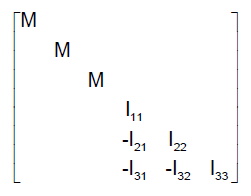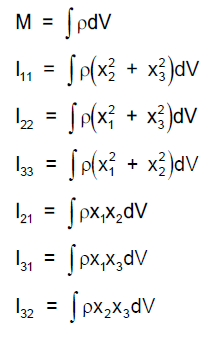Description
The CONM2 entry defines a concentrated mass at a grid point. The CONM2 entry is also used to define mass properties for a rigid body
The use of the CONM2 entry for Autodesk Explicit has been modified from the original CONM2 entry for Nastran. If the grid point, G, listed on the entry is the same as a reference node for a rigid body, the mass properties on the CONM2 entry are applied to a rigid body.
Format
| 1 | 2 | 3 | 4 | 5 | 6 | 7 | 8 | 9 | 10 |
| CONM2 | EID | G | CID | M | X1 | X2 | X3 | ||
| I11 | I21 | I22 | I31 | I32 | I33 |
Example
| CONM2 | 1 | 2 | 12 | ||||||
| 23.5 | 32.6 | 12.8 |
| Field | Definition | Type | Default |
|---|---|---|---|
| EID | Element identification number. | Integer > 0 | Required |
| G | Grid point identification number. See Remark 2. | Integer > 0 | Required |
| CID | Coordinate system identification number. | Integer ≥ 0 | 0 |
| M | Mass value. | Real | Required |
| X1, X2, X3 | Offset distances. These are currently not used by Autodesk Explicit. | Real or blank | Required |
| Iij | Mass moments of inertia added to the calculated inertia tensor for the rigid body. The inertia terms are defined in terms of the coordinate system referenced by the coordinate system identification number CID. See Remark 5. | I11, I22, and I33, Real ≥ 0.0; I21, I31, and I32, Real ≥ 0.0. | 0.0 |
Remarks
- Element identification numbers must be unique with respect to all other element identification numbers.
- If the grid point identification number, G, is the same as the reference node for a rigid body, the mass and inertia terms are added to the mass and inertia calculated from the rigid body definition. If the grid point identification number, G, is not the reference node for a rigid body, the mass is simply added to the grid point defined by G.
- The coordinate system identification is used only if the CONM2 entry references a rigid body.
- The X1, X2 and X3 offsets are not used by Autodesk Explicit.
- The continuation entry may be omitted.
- The form of the inertia matrix about its center of gravity is taken as follows:

In the equations above:

If the CONM2 entry references a rigid body, the mass M is added to the mass that is initially computed for the rigid body, Mc. The total mass for the rigid body M is M+Mc.
X1, X2, and X3 are components of distance from the center of gravity in the coordinate system defined in field 4. Only the magnitude of Iij should be supplied; the negative signs for the off-diagonal terms are supplied automatically. The inertia terms are transformed to the principal coordinate system for the inertia tensor for the rigid body.
